
The Taunus is a mountain range in Hesse, Germany, located north west of Frankfurt and north of Wiesbaden. The tallest peak in the range is Großer Feldberg at 878 m; other notable peaks are Kleiner Feldberg and Altkönig.
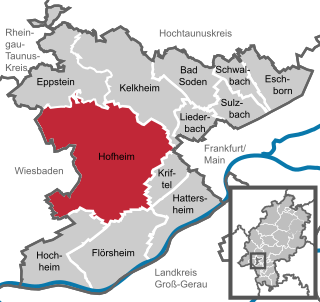
Hofheim is the administrative centre of Main-Taunus-Kreis district, in the south of the German state of Hesse. Its population in September 2020 was 39,946.

Ernst Klee was a German journalist and author. As a writer on Germany's history, he was best known for his exposure and documentation of medical crimes in Nazi Germany, much of which was concerned with the Action T4 or involuntary euthanasia program. He is the author of "The Good Old Days": The Holocaust Through the Eyes of the Perpetrators and Bystanders first published in the English translation in 1991.
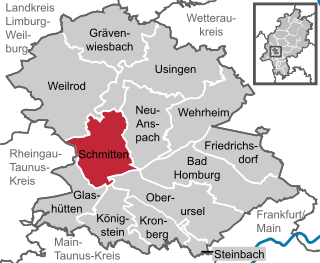
Schmitten im Taunus is a municipality in the Hochtaunuskreis in Hessen, Germany.
Die Tat was a German monthly publication of politics and culture. It was founded in April 1909 and its publisher was Eugen Diederichs from Jena. From 1939 until 1944 Die Tat was continued as Das XX. Jahrhundert.

Schwalbach am Taunus, a town in the Main-Taunus-Kreis district, in Hesse, Germany, population about 14,000, is a dormitory town to Frankfurt, situated some 11 km east of Schwalbach. There is evidence of human habitation dating back to Neolithic times, and recorded history going back to 781 AD. Until the end of the Second World War, it was a farming village, but in the post-war era it expanded rapidly and became economically linked to Frankfurt. Schwalbach was granted Gemeinde (municipal) status in 1970.

Glashütten is a small municipality in the Hochtaunuskreis. This community in the Taunus, which is made up of the three formerly independent communities of Glashütten, Schloßborn and Oberems, lies in the Hochtaunus Nature Park, not far from Königstein im Taunus, Germany.
The Taunus Railway in the High Taunus is a railway route between Frankfurt (Main) Hauptbahnhof and Brandoberndorf via Bad Homburg, Usingen and Grävenwiesbach. It was operated from 1993 to 1995 by the Frankfurter Verkehrsverbund as the T-Bahn and subsequently by the Rhein-Main-Verkehrsverbund as line 15. It is listed in table 637 of the Deutsche Bahn timetable. The Friedrichsdorf–Brandoberndorf line, which has the infrastructure number of 9374, forms part of the old Friedrichsdorf–Wetzlar line, which was known as the Taunusbahn. The line is owned by the Verkehrsverband Hochtaunus. The infrastructure is managed by HLB Basis AG on behalf of the VHT.

The Diocese of Limburg is a Latin Church diocese of the Catholic Church in Germany. It belongs to the ecclesiastical province of Cologne, with metropolitan see being the Archdiocese of Cologne.

Eugen Kogon was a German historian and Nazi concentration camp survivor. A well-known Christian opponent of the Nazi Party, Kogon was arrested more than once and spent six years at Buchenwald concentration camp. Known in Germany as a journalist, sociologist, political scientist, author, and politician, he went on to be considered one of the "intellectual fathers" of both West Germany and European integration. His 1946 book The Theory and Practice of Hell still stands as a basic reference on Nazi crimes.

Bad Homburg station is located in Bad Homburg, Hesse, Germany on the Homburg Railway and was opened on 26 October 1907. It is used by about 19,000 passengers each day.
Hermann Karl Lenz was a German writer of poetry, stories, and novels. A major part of his work is a series of nine semi-autobiographical novels centring on his alter ego "Eugen Rapp", a cycle that is also known as the Schwäbische Chronik.
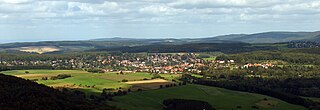
Schloßborn (Schlossborn) is a village in the municipality of Glashütten, Hesse, Germany. It is located northeast of Wiesbaden and northwest of Frankfurt in the hilly Taunus region.

The Upper Germanic-Rhaetian Limes, or ORL, is a 550-kilometre-long section of the former external frontier of the Roman Empire between the rivers Rhine and Danube. It runs from Rheinbrohl to Eining on the Danube. The Upper Germanic-Rhaetian Limes is an archaeological site and, since 2005, a UNESCO World Heritage Site. Together with the Lower Germanic Limes it forms part of the Limes Germanicus.

Peter Reulein is a German composer, organ improviser, academic teacher and church musician, from 2000 at the church Liebfrauen in Frankfurt am Main. In 2016 he composed for the Catholic Diocese of Limburg the Franciscan oratorio Laudato si'.
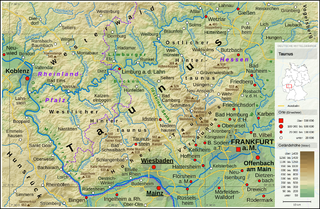
The High Taunus is the name of a major natural region unit in the Hessian Central Uplands range of the Taunus mountains and forms the area immediately around the main ridge of the Taunus. It should not be confused with the term Hochtaunus, in the sense used in the name of the county of Hochtaunuskreis which is only the eastern part of the Feldberg massif. The High Taunus separates the Anterior Taunus in the south from the Lower Taunus in the north and includes the majority of the highest mountains and hills of the Taunus. The eastern part of the natural region lies within the Taunus Nature Park and its western part in the Rhine-Taunus Nature Park.

The main ridge of the Taunus is a 75-kilometre-long ridgeline in the High Taunus mountain in Germany, whose geological core consists of veins of hard Taunus quartzite. The ridge separates the steeply descending Anterior Taunus to the south from the more gradually descending upland of the Hintertaunus or Farther Taunus in the north. The watershed between the Upper Rhine and River Main to the south and the Middle Rhine tributaries of the Wisper and Lahn to the north, runs for long sections along the main ridge. Several of the rivers flowing southwards have broken through the rock of the Taunus ridge unit in several places so the watershed is diverted a few kilometres to the north.
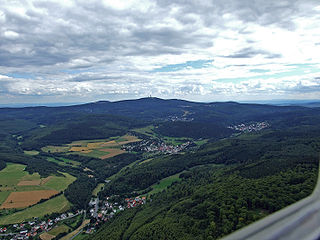
The Taunus Nature Park is a nature park in Central Germany with an area of 134,775 hectares (1347.75 km2) in the Central Upland range of the Taunus. It is one of two Hessian nature parks in the Taunus and the second largest nature park in Hesse.
Mahinland was a piece of land in the coast east of Lagos on the Bight of Benin in modern Nigeria. In the late 19th century it was briefly the object of German colonial initiatives.
















